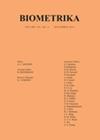Selective conformal inference with false coverage-statement rate control
IF 2.8
2区 数学
Q2 BIOLOGY
引用次数: 0
Abstract
Conformal inference is a popular tool for constructing prediction intervals. We consider here the scenario of post-selection/selective conformal inference, that is prediction intervals are reported only for individuals selected from unlabelled test data. To account for multiplicity, we develop a general split conformal framework to construct selective prediction intervals with the false coverage-statement rate control. We first investigate benjamini2005false's false coverage rate-adjusted method in the present setting, and show that it is able to achieve false coverage-statement rate control but yields uniformly inflated prediction intervals. We then propose a novel solution to the problem called selective conditional conformal prediction. Our method performs selection procedures on both the calibration set and test set, and then constructs conformal prediction intervals for the selected test candidates with the aid of conditional empirical distribution obtained by the post-selection calibration set. When the selection rule is exchangeable, we show that our proposed method can exactly control the false coverage-statement rate in a model-free and distribution-free guarantee. For non-exchangeable selection procedures involving the calibration set, we provide non-asymptotic bounds for the false coverage-statement rate under mild distributional assumptions. Numerical results confirm the effectiveness and robustness of our method in false coverage-statement rate control and show that it achieves more narrowed prediction intervals over existing methods across various settings.带错误覆盖率控制的选择性保形推理
共形推理是构建预测区间的常用工具。我们在此考虑的是后选择/选择性共形推理的情况,即预测区间仅针对从无标签测试数据中选出的个体进行报告。为了考虑多重性,我们开发了一个通用的分裂保形框架,以构建具有错误覆盖率控制的选择性预测区间。我们首先研究了 benjamini2005false 在当前环境下的虚假覆盖率调整方法,结果表明该方法能够实现虚假覆盖率控制,但会产生均匀膨胀的预测区间。然后,我们提出了一种新的解决方案,称为选择性条件保形预测。我们的方法同时对校准集和测试集执行选择程序,然后借助选择后校准集获得的条件经验分布为选定的候选测试构建保形预测区间。当选择规则是可交换的时,我们证明我们提出的方法可以在无模型和无分布的保证下精确控制错误覆盖率。对于涉及校准集的不可交换选择程序,我们在温和的分布假设条件下提供了虚假覆盖率的非渐近界限。数值结果证实了我们的方法在控制虚假覆盖率方面的有效性和稳健性,并表明在各种情况下,我们的方法比现有方法实现了更窄的预测区间。
本文章由计算机程序翻译,如有差异,请以英文原文为准。
求助全文
约1分钟内获得全文
求助全文
来源期刊

Biometrika
生物-生物学
CiteScore
5.50
自引率
3.70%
发文量
56
审稿时长
6-12 weeks
期刊介绍:
Biometrika is primarily a journal of statistics in which emphasis is placed on papers containing original theoretical contributions of direct or potential value in applications. From time to time, papers in bordering fields are also published.
 求助内容:
求助内容: 应助结果提醒方式:
应助结果提醒方式:


